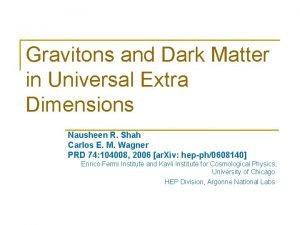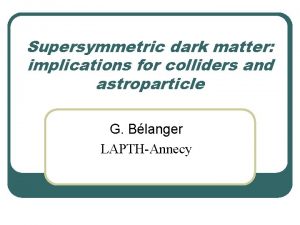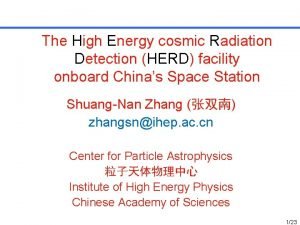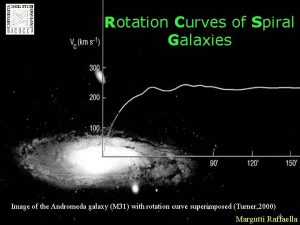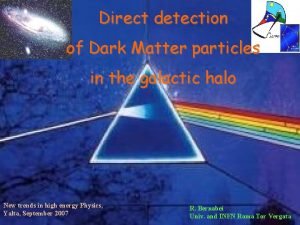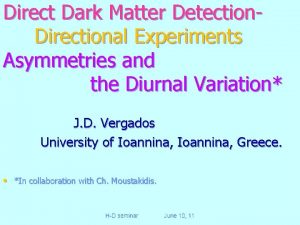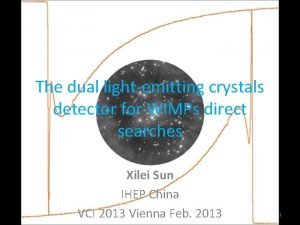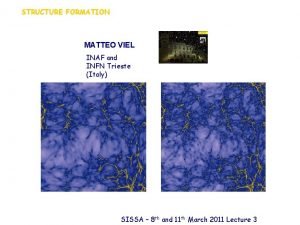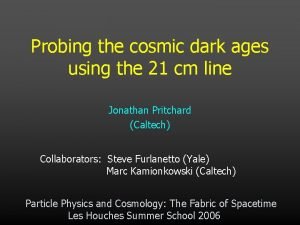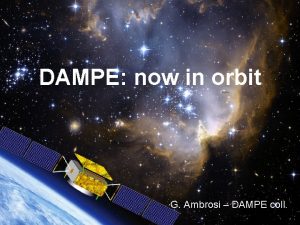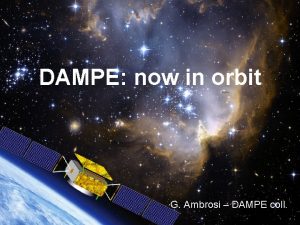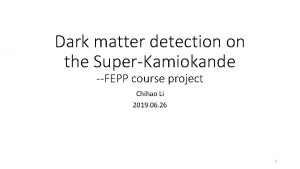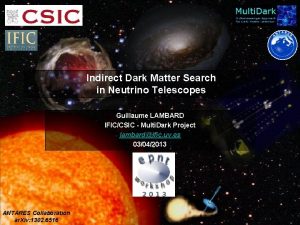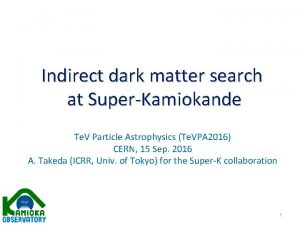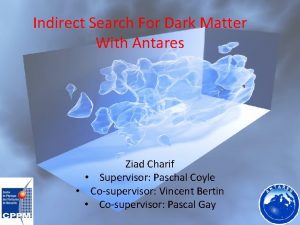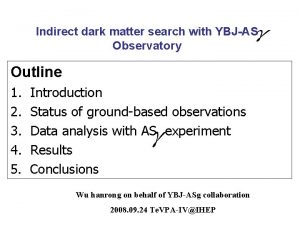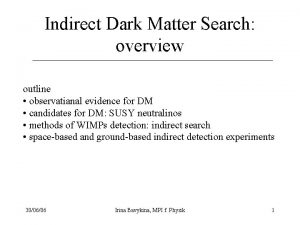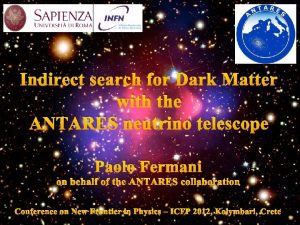FEPP Final Report DAMPE Indirect Dark Matter Search














![Main References [1] J. Chang, G. Ambrosi et. al. , The Dark Matter Particle Main References [1] J. Chang, G. Ambrosi et. al. , The Dark Matter Particle](https://slidetodoc.com/presentation_image_h2/15eccf12c95dbe923afa737fe9c91d12/image-15.jpg)
![Main References [6] Tiekuang Dong, Yapeng Zhang et. al. , Charge measurement of cosmic Main References [6] Tiekuang Dong, Yapeng Zhang et. al. , Charge measurement of cosmic](https://slidetodoc.com/presentation_image_h2/15eccf12c95dbe923afa737fe9c91d12/image-16.jpg)

- Slides: 17

FEPP Final Report DAMPE (Indirect Dark Matter Search) Zhibo Wu, USTC 2019. 06. 26 1

Outline • Dark matter signal candidates • The DAMPE instrument • Event reconstruction • Electron/proton discrimination • Physics results 2

Dark Matter Signal Candidates • 3

The DAMPE Instrument Sub-detectors: • PSD • STK • BGO Calorimeter • NUD 4

The DAMPE Instrument Plastic Scintillator Detector Task: Measure |Z| of incident high-energy particles. Structure: • 82 plastic scintillator in two planes • Double dynode readout 5

The DAMPE Instrument Silicon-Tungsten trac. Ker Task: • Measure charges & trajectories • Reconstruct the direction of photons Structure: • 6 double-planes of silicon detectors • Multiple tungsten layers 6

The DAMPE Instrument BGO Calorimeter Task: • Energy deposition • e/P identification Structure: • 14 Layersⅹ 22 BGO bars • Three dynode readout 7

The DAMPE Instrument • 8

Event Reconstruction • Energy: Signals (ADC counts) from proper dynodes are converted into energy. Total deposited energy: summing up the energies of all BGO crystals. • Track: (1) BGO: “Cluster” of fired BGO bars are built according to energy deposit. The positions of bars in the cluster will be fitted linearly. (2) STK: Select strips with high S/N ratio. The Kalman filter is then performed offline on the ground. • Charge By evaluating the path length, the position, the incidence angle and energy values from PSD & STK. 9

Electron/Proton Discrimination • The development of showers in BGO Showers initiated by electrons and protons behave differently in the BGO calorimeter. • NUD can further discriminate EM / hadronic showers 10

Physics Results • Cosmic Ray Electron (CRE) spectrum from 55 Ge. V to 2. 63 Te. V has been fitted: An energy break in the spectrum at around 0. 9 Te. V. • The evidence for a signal around 1. 4 Te. V is not statistically compelling. 11

Electron/Proton Discrimination • Constraints on the DM mass & annihilation cross section for μ+μ- channel 12

Electron/Proton Discrimination • Constraints on DM Favored DM parameter region. Combined with astrophysics observation, the annihilation or decay channels can hardly survive. DM models have to be tuned. • e+e- Channels: excluded by DAMPE+AMS-02; • τ Channels: too many photons; • Other annihilation channels: constraint by astrophysical observation; • Decay channels: severely constraint by EGRB data. 13

Summary DAMPE is a successful space-based experiment. • Well-designed and functioning detector systems; • Powerful reconstruction and identification algorithm; • Important physics results: (1) An energy break in CRE spectrum; (2) No compelling evidence for 1. 4 Te. V CRE signal; (3) Favored DM parameter regions mostly excluded. Thank You! 14
![Main References 1 J Chang G Ambrosi et al The Dark Matter Particle Main References [1] J. Chang, G. Ambrosi et. al. , The Dark Matter Particle](https://slidetodoc.com/presentation_image_h2/15eccf12c95dbe923afa737fe9c91d12/image-15.jpg)
Main References [1] J. Chang, G. Ambrosi et. al. , The Dark Matter Particle Explorer mission, Astroparticle Physics, 95 (2017) 6– 24. [2] T. Bringmann, C. Weniger, Gamma ray signals from dark matter: Concepts, status and prospects, Dark Universe 1 (2012) 194– 217. [3] Yifeng Wei, Yunlong Zhang, Performance of the DAMPE BGO calorimeter on the ion beam test, Nuclear Inst. and Methods in Physics Research, A 922 (2019) 177– 184. [4] Rui Qiao et. al. , Charge reconstruction of the DAMPE Silicon. Tungsten Tracker: A preliminary study with ion beams, Nuclear Inst. and Methods in Physics Research, A 886 (2018) 48 -52. [5] A. Tykhonov et. al. , Interal alignment and position resolution of the silicon tracker of DAMPE determined with orbit data, Nuclear Inst. and Methods in Physics Research, A 893 (2018) 43 -56. 15
![Main References 6 Tiekuang Dong Yapeng Zhang et al Charge measurement of cosmic Main References [6] Tiekuang Dong, Yapeng Zhang et. al. , Charge measurement of cosmic](https://slidetodoc.com/presentation_image_h2/15eccf12c95dbe923afa737fe9c91d12/image-16.jpg)
Main References [6] Tiekuang Dong, Yapeng Zhang et. al. , Charge measurement of cosmic ray nuclei with the plastic scintillator detector of DAMPE, Astroparticle Physics 105 (2019) 31 -36. [7] DAMPE Collaboration, First data from the DAMPE space mission, Nuclear and Particle Physics Proceedings 291 -293 (2017) 59 -65. [8] DAMPE Collaboration, Direct detection of a break in the teraelectronvolt cosmic-ray spectrum of electrons and positrons, nature, Vol. 552, 7 December 2017, 63 -66. [9] Andrew Fowlie, DAMPE squib? Significance of the 1. 4 Te. V DAMPE excess, Physics Letters B 780 (2018) 181– 184. [10] Q. Yuan, L. Feng et. al. , Interpretations of the DAMPE electron data, Ar. Xiv e-prints (2017), ar. Xiv: 1711. 10989 [astroph. HE]. 16

Backup 17
 Dark matter and dark energy presentation
Dark matter and dark energy presentation In a dark dark town
In a dark dark town Dark matter just gravitons dimensions
Dark matter just gravitons dimensions Boosted dark matter
Boosted dark matter Dark matter
Dark matter Dark matter pwo
Dark matter pwo Dark matter physics
Dark matter physics Where to stream dark matter
Where to stream dark matter What could dark matter be
What could dark matter be Dark matter
Dark matter Matteo viel
Matteo viel Dark matter
Dark matter Les houches dark matter
Les houches dark matter Classification of matter section 1 composition of matter
Classification of matter section 1 composition of matter Meysam golmohammadi
Meysam golmohammadi Section 1 composition of matter
Section 1 composition of matter Chapter 2 matter section 1 classifying matter answer key
Chapter 2 matter section 1 classifying matter answer key Median and lateral apertures
Median and lateral apertures


